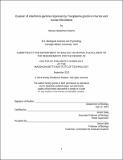| dc.contributor.advisor | Jeroen Saeij. | en_US |
| dc.contributor.author | Roberts, Wendy Niedelman | en_US |
| dc.contributor.other | Massachusetts Institute of Technology. Department of Biology. | en_US |
| dc.date.accessioned | 2014-01-09T18:55:07Z | |
| dc.date.available | 2014-01-09T18:55:07Z | |
| dc.date.issued | 2013 | en_US |
| dc.identifier.uri | http://hdl.handle.net/1721.1/83638 | |
| dc.description | Thesis (Ph. D.)--Massachusetts Institute of Technology, Dept. of Biology, 2013. | en_US |
| dc.description | This electronic version was submitted by the student author. The certified thesis is available in the Institute Archives and Special Collections. | en_US |
| dc.description | Cataloged from student-submitted PDF version of thesis. | en_US |
| dc.description | Includes bibliographical references. | en_US |
| dc.description.abstract | Co-evolution of pathogen and host helps drive biological diversity. Unlike viral-host interactions, little is known about the co-evolution of eukaryotic pathogens with their hosts. The intracellular parasite Toxoplasma gondii is an excellent model organism for co-evolution studies because its hosts include all warm-blooded animals, and genetically diverse Toxoplasma strains may be adapted to specific hosts. Toxoplasma must evade host immunity without killing the host to establish a chronic infection and ensure transmission. Interferon-gamma (IFNγ) activation of non-immune cells is crucial for host defense against Toxoplasma. In murine cells, interferon-inducible immune-related GTPases (IRGs) are essential to the IFN[gamma] response because they disrupt the parasitophorous vacuole (PV). However, Toxoplasma secretes the contents of apical secretory organelles into the host cell during invasion, and some of these proteins strain-specifically promote mouse virulence by inactivating the IRGs. Here, we show that two secreted Toxoplasma factors, the protein kinase ROP18 and the pseudokinase ROP5, determine IRG evasion. We demonstrate that ROP5 binds to and inhibits the oligomerization of Irga6, allowing ROP18 to phosphorylate the IRGs to inhibit PV accumulation. However, humans lack interferon-inducible IRGs, and ROP5 and ROP18 do not affect Toxoplasma growth inhibition in human cells, suggesting these factors specifically evolved to battle the IRG system. Both ROP5 and the IRGs exhibit diversifying selection, and these proteins may provide a model for study of eukaryotic pathogen-host co-evolution. We also uncover a novel mechanism of IFN[gamma]-mediated Toxoplasma growth inhibition in human fibroblasts that correlates with host cell death that cannot be abrogated by inhibiting cell death pathways. Furthermore, we observed parasite egress from IFN[gamma]-stimulated cells before replication, but inhibition of egress did not prevent cell death. Thus, the inhospitable intracellular environment of dying IFN[gamma]-stimulated human fibroblasts triggers parasite egress. This disrupts the intracellular niche, prevents replication and could promote immune clearance or depletion of parasite secretory factors. This work highlights the need for a parasite to balance immune evasion for increased parasite propagation with limiting parasite burden for host and parasite survival. Thus, host immune factors and parasite immune evasion factors have co-evolved, and strain differences may be due to adaptation to different hosts. | en_US |
| dc.description.statementofresponsibility | by Wendy Niedelman Roberts. | en_US |
| dc.format.extent | 143 pages | en_US |
| dc.language.iso | eng | en_US |
| dc.publisher | Massachusetts Institute of Technology | en_US |
| dc.rights | M.I.T. theses are protected by
copyright. They may be viewed from this source for any purpose, but
reproduction or distribution in any format is prohibited without written
permission. See provided URL for inquiries about permission. | en_US |
| dc.rights.uri | http://dspace.mit.edu/handle/1721.1/7582 | en_US |
| dc.subject | Biology. | en_US |
| dc.title | Evasion of interferon-gamma responses by Toxoplasma gondii in murine and human fibroblasts | en_US |
| dc.type | Thesis | en_US |
| dc.description.degree | Ph.D. | en_US |
| dc.contributor.department | Massachusetts Institute of Technology. Department of Biology | |
| dc.identifier.oclc | 864901157 | en_US |
